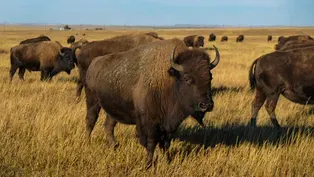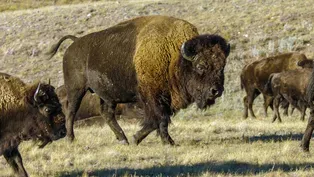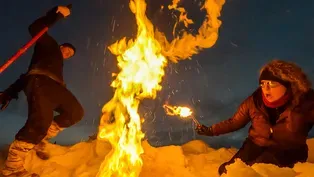
Antarctic Fur Seals vs. Leopard Seals
Clip: Episode 4 | 7m 20sVideo has Closed Captions
Antarctic fur seals need ice-free ground in order to breed. Why are they disappearing?
Leopard seals are the only seals that prey on other seal species although fur seals have rarely been on the menu before. These leopard seals should be living in sea ice, hunting other ice-dwelling seals but they have switched to a new food source.

Antarctic Fur Seals vs. Leopard Seals
Clip: Episode 4 | 7m 20sVideo has Closed Captions
Leopard seals are the only seals that prey on other seal species although fur seals have rarely been on the menu before. These leopard seals should be living in sea ice, hunting other ice-dwelling seals but they have switched to a new food source.
How to Watch Dynamic Planet
Dynamic Planet is available to stream on pbs.org and the free PBS App, available on iPhone, Apple TV, Android TV, Android smartphones, Amazon Fire TV, Amazon Fire Tablet, Roku, Samsung Smart TV, and Vizio.
Buy Now
Providing Support for PBS.org
Learn Moreabout PBS online sponsorshipnarrator: There are indications that the natural world is out of balance all over our Earth... [soft music] Especially on the Antarctic Peninsula.
♪ ♪ For millennia, only animals adapted to extreme cold have survived here, but climate change has radically transformed their habitat in a few short years.
♪ ♪ For some animals, that can actually be good news.
Antarctic fur seals, for instance, don't really like the ice.
Like monarch butterflies, these seals are an indicator species, and the indications should be good.
- Antarctic fur seals need ice-free ground in order to breed.
This is a population that experts thought would be climate change winners, that they would be doing better as the climate warmed, as ice receded.
But in fact, here at Cape Shirreff, the numbers have dropped catastrophically.
narrator: Doug Krause heads up the seal program at the Cape Shirreff research station.
[tense music] He wants to know why the seals are disappearing.
♪ ♪ - The first several years that I was here, there were fur seals everywhere.
We used to have pups up on the deck at this time of year, playing around.
You could hear them as you went to sleep at night.
And now we just hear silence.
[tense music] narrator: Scientists initially suspected that global warming was messing with the fur seals' food supply, but over the years, Doug has zeroed in on a different suspect.
♪ ♪ - You will never forget the first time that you see a leopard seal.
♪ ♪ They're approximately the size of an adult male grizzly bear, ancient, serpentine.
♪ ♪ narrator: Leopard seals are the only seals that prey on other seal species, although fur seals have rarely been on the menu before.
- Come on, girl.
Where are you?
narrator: Doug has attached monitoring equipment to leopard seals to find out whether this has changed.
- She's got some really valuable data attached to her back.
[tense music] narrator: But to retrieve it, he'll need some help.
♪ ♪ - The capture of a leopard seal involves a team of at least four or five people all working together.
Anyone who tells you that they are not really nervous about the whole thing is absolutely lying.
These are huge, dominant apex predators.
We have finally located probably the most persnickety and evasive leopard seal we've ever had here, and I'm very happy to say that she is asleep on this very beach.
♪ ♪ What I've got in this dart right now would be enough to overdose six adult human beings.
So that's why I'm extremely careful with the dart.
♪ ♪ [dart thwacks] [seal growling] ♪ ♪ I'm just testing her level of sedation.
Just give her a sec.
♪ ♪ Got all our measurements and instruments and data back, and I'm about to give her the reversal agents.
And she's gonna wake up pretty quickly and hopefully go back to sleep or go to sea.
♪ ♪ [birds calling] narrator: These leopard seals should be living in sea ice, hunting other ice-dwelling seals.
But summer sea ice is a thing of the past in this part of Antarctica.
Doug's work reveals that rather than follow the retreating ice, these leopard seals have switched to a new food source.
[dramatic music] - Antarctic fur seal pups don't react to the presence of this large predator.
♪ ♪ They are a temperate evolved species.
They actually haven't been in the Antarctic for that long and don't know to be scared or avoid leopard seals when they see them.
♪ ♪ narrator: Doug's recordings show that leopard seals can get within inches of their prey without causing alarm.
♪ ♪ - She's moving in, just her nose and her eyes above the waterline.
♪ ♪ And then she just rushes in... ♪ ♪ Grabs a pup right by the head.
♪ ♪ narrator: Cape Shirreff's fur seals are unexpected losers in a warming world.
♪ ♪ - Leopard seals have consumed over 70% of the pups that were born this year.
♪ ♪ And at some point, the fur seal population is either going to simply disappear, or the leopard seals are going to need to move on to another resource.
♪ ♪ narrator: It's anyone's guess what the adaptable leopard seals will do next.
♪ ♪ This environment has been thrown off-kilter so fast that it hasn't yet reached a new equilibrium.
♪ ♪
Video has Closed Captions
For the Blackfeet Tribe, bringing back buffalo will revitalize the landscape. (5m 23s)
Video has Closed Captions
Amid the world’s ecosystems in chaos, can science, nature, and tradition prepare us for the future? (30s)
Finding Methane Bubbles in Permafrost
Video has Closed Captions
The ground is made up of both ice and frozen soil called permafrost. (2m 40s)
Providing Support for PBS.org
Learn Moreabout PBS online sponsorship













